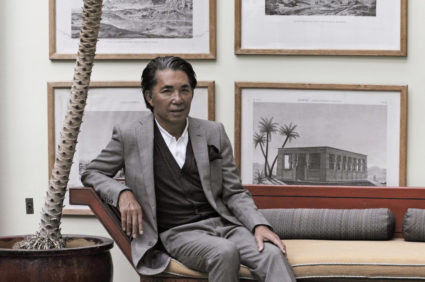
The National Trust for Historic Preservation, a privately funded group, is asking the U.S. District Court to block Trump’s White…

PARIS — Kenzo Takada, the iconic Franco-Japanese fashion designer famed for his jungle-infused designs and free-spirited aesthetic that channeled global travel, has died. He was 81.
The family said in a statement to French media Sunday that Takada died from complications from COVID-19 in a hospital in Neuilly-sur-Seine, near Paris. A public relations officer for Kenzo's brand confirmed that Takada died, but didn't give a cause of death.
The fashion house issued a statement on Instagram: "It is with immense sadness that KENZO has learned of the passing of our founder… for half a century, Mr. Takada has been an emblematic personality in the fashion industry – always infusing creativity and color into the world."
Though Takada had been retired from his house since 1999 to pursue a career in art, Kenzo remains one of the most respected fixtures of the high Paris fashion. Since 1993, the brand Kenzo has been owned owned by the French luxury goods company LVMH. The current designer Felipe Oliveira Baptista unveiled Kenzo's spring-summer 2020 to fashion editors on Wednesday.

"His amazing energy, kindness, talent and smile were contagious," Oliveira Baptista said. "His kindred spirit will live forever."
Kenzo's styles used bold color, clashing prints and were inspired by travels all over the world.
Takada was born on Feb. 27, 1939, in Himeji, in the Hyogo Prefecture in Japan to hoteliers, but after reading his sisters' fashion magazines his love of fashion began.
Studying at the Bunka College of Fashion in Tokyo, Kenzo Takada had a brief stint working in Japan, before relocating to Paris in 1965, to work as a freelance designer.

In Paris, he took over a boutique in 1970 which served crystallized his future ready-to-wear aesthetic, and was inspired in its decoration by the jungle scenes of painter Henri Rousseau, which he merged with Asian styles. It became influential.
But it was lowly beginnings: Takada's first collection at the store called was made entirely out of cotton because he had little money. But the clothes spoke for themselves and a model of his was put on the cover of Elle magazine. A short time after, pioneering shoulder forms, large armholes, dungarees, smock tent dresses, innovative shoulder shapes, and his store was featured in US Vogue. Kenzo showed collections in New York and Tokyo in 1971.

Yves Saint Laurent was an important inspiration, in his work, Takada has said. Takada shared Saint Laurent's penchant for theatrics. in 1978 and 1979, he showed in a circus tent, and it featured himself riding an elephant, and performers rode horses wearing see-through uniforms.
Takada's love of travel and use of ethnic influences were strong features in his three decades atop his house.
His contribution to style was significant. He championed a youthful aesthetic and unstructured form, and did away with zippers to liberate silhouettes. His signatures were of wider sleeves and arm holes, that harked to historic styles in his home continent of Asia.
Sustain our coverage of culture, arts and literature.